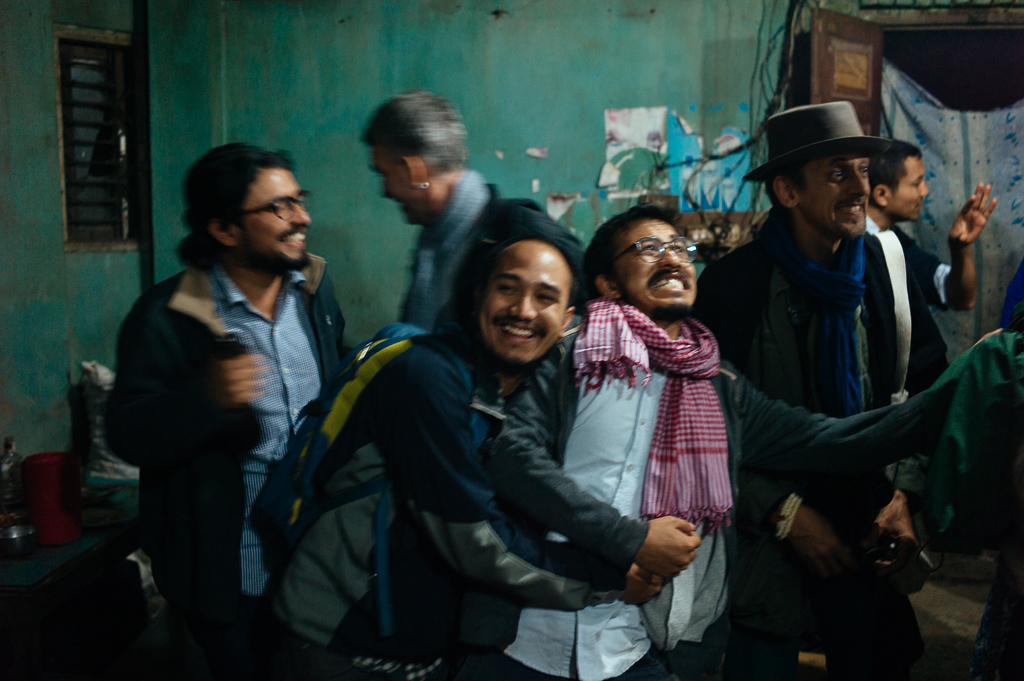
(De)constructing the gaze
Some considerations
about the Nepali photographic scene in 2016
By Frédéric Lecloux, with inputs from NayanTara Gurung Kakshapati
In October 2012, an exhibition entitled Népal Intime was exhibited at the Fondation Alliance Française in Paris. The first of its kind to go abroad, it featured works by young Nepali photographers, including Prasiit Sthapit and NayanTara Gurung Kakshapati, as well as the collective series Kathmandu Kathmandu. It was curated by photo.circle, a Nepali platform for promoting and teaching photography in Nepal. At the time, photo.circle had only existed for five years, but had already patiently invested in the field of community building in photography education, be it in terms of image reading, storytelling or technical prowess.
I had the honour of writing the introductory text for the show, an excerpt of which reads: “a young generation of photographers has come to the fore, much more confident in their own strengths and legitimacy to speak up on their surroundings and the world at large as compared to their predecessors. They’ve educated themselves, they practice unremittingly, they contribute to newspapers and magazines while at the same time engaging in personal projects, they shake the old codes of photojournalism, they attend workshops, travel around Nepal and overseas, and as a result, are deeply aware of the problems confronting Nepal in the 21st century. In short, they embody the power of photography as a language not to tell the world as it is, but because they have surpassed the myth of objectivity, to tell the world as they see it.”
Something was changing, even mushrooming within their practice. The risk of emulating and enforcing western norms and tropes was considered as a viable shortcoming of the process, even if a decision was made to actively choose it. However, four years have elapsed since that moment. Contrary to our preliminary apprehensions, they have followed their own path and evolved personal trajectories through experience.
Indeed, serious photographers in Nepal are not interested in becoming clones of their masters, whether it be Mani Lama or Bikas Rauniar as adept, local freelancers or assignment photographers, the renowned Australian photographer, Philip Blenkinsop or pioneering American documentary practitioner, Kevin Bubriski, to name but a few who have been directly linked to Nepal. They respect them, celebrate them and acknowledge the importance of their contributions to the greater conversation of photography. Furthermore, the younger photographers are now growing through knowledge of the history of the medium in the Nepali context thanks to Nepal Picture Library, the digital archive created by photo.circle.
This community of photographers has hence grown in its ranks. Prasiit Sthapit is one of them, who in 2016 received a Magnum Emergency Fund grant and has since been awarded a prized seat in this year’s Joop Swart Masterclass run by World Press Photo. But they are many others, such Kishor K. Sharma, Sagar Chhetri, Surendra Lawoti, Karma Tshering Gurung who are inventing the future of Nepali photography. Photographers know what they can find in a space like photo.circle: a space for reflection and interrogation, a motivation to move forward with their projects – but that always comes with an incentive not to walk the easy path or to compromise artistic engagement. Inspired by their action, other groups of photo enthusiasts have emerged in the country, like Sanskriti in Birgunj.
Two events recently gave many photographers from within and outside Nepal the opportunity to exert their freedom of expression and to confirm the clairvoyance of their vision. These can be regarded as event-based landmarks in the relationship of Nepal to its representation.
The first was the earthquake of 25 April, 2015. Nepali photographers understood from the very next day that if they wanted to keep a track of their experience of – and in – the disaster, they would have to do the job themselves. That’s how the Nepal Photo Project was born. This doesn’t mean that the Nepali audience is not open to respectful and insightful visions of their country coming from elsewhere. It simply means that they too are able to view the world with a critical eye.
The second event was Photo Kathmandu, Nepal’s first photo festival, launched by photo.circle in 2015. Among the many lessons to be learned from that extraordinary week, was attention to the audience. With 18 exhibitions displayed on the streets of Patan, Photo Kathmandu demonstrated that photography can be put in conversation with the city, with urban youth to hill farmers, from the shoe-shine boy to the office employee. During projections in Patan’s dhunge dharas (water taps) where locals were washing their laundry in the middle of the images, photography proved to be a language speaking to all, regardless of their age or education.
Challenges ahead are huge, though. First and foremost, the actors of photography in Nepal have to consolidate these achievements, yet in a country without a state. The second edition of Photo Kathmandu next month (October 2016) will be an important test in that respect. It will also be the opportunity to raise once again the question of the dissemination of the pictures. photo.circle has been aware of this since the beginning: it is all very well to have contributed to the rise of an entire generation of photographers driven by a powerful vision, nevertheless there lacks space to show their works. Photo Kathmandu is one such space. The national press is another. But this is not enough. Given how many stories deserve to be told and the talent of the storytellers, there is a need for new spaces for photography.
Finally the subjugation exerted by social media, the fabrication of meaning in an era of overabundance of images, the fast-moving boundaries of a medium that is however still in its infancy, the necessity to understand, as Jörg Colberg recently put it, “how or where what one does is located in the vast continuum of all the work that already exists and/or is being made”… all these are contemporary realities that all photographers have to face, and that will thus require Nepali photographers to remain open to the world.
They are on the right path.
Photograph: Shikhar Bhattarai, Søren Pagter, Nishant Shilpakar, Prasiit Sthapit, Philip Blenkinsop and Bhushan Shilpakar during Photo Kathmandu 2015, Lalitpur, Nepal, 5 November 2015.
Article published in a special newsletter by Indian Quarterly Pix in September 2016.
Kindly proofread by Nandita Jayshankar NayanTara Gurung Kakshapati.

